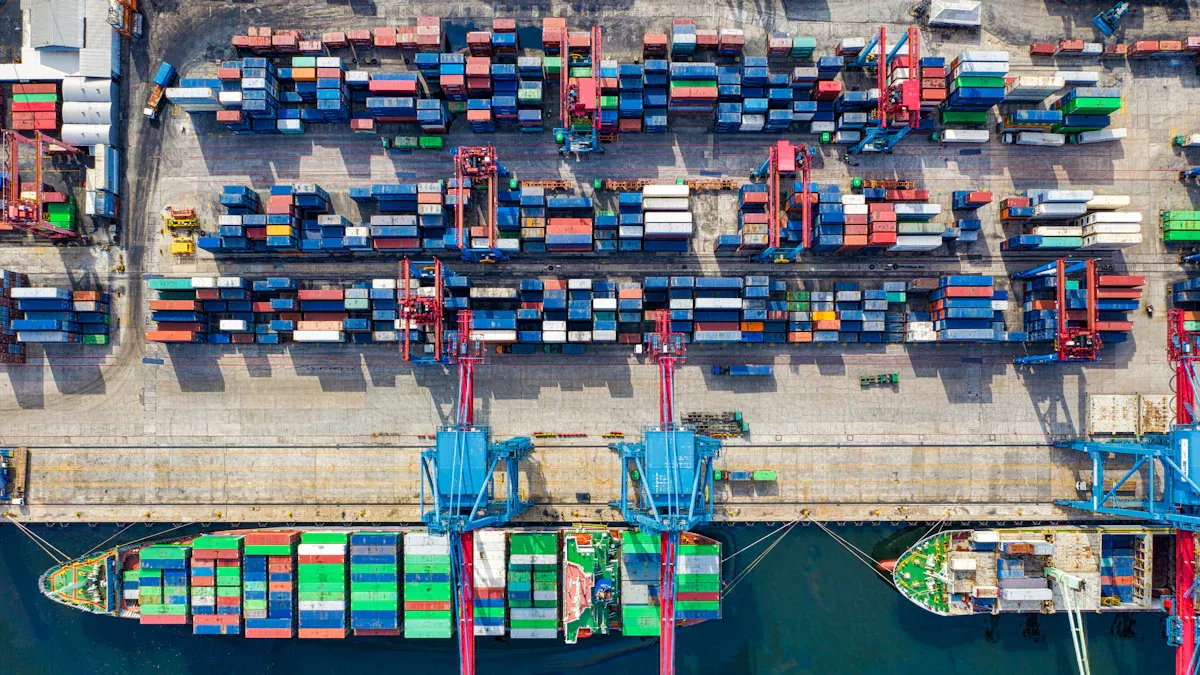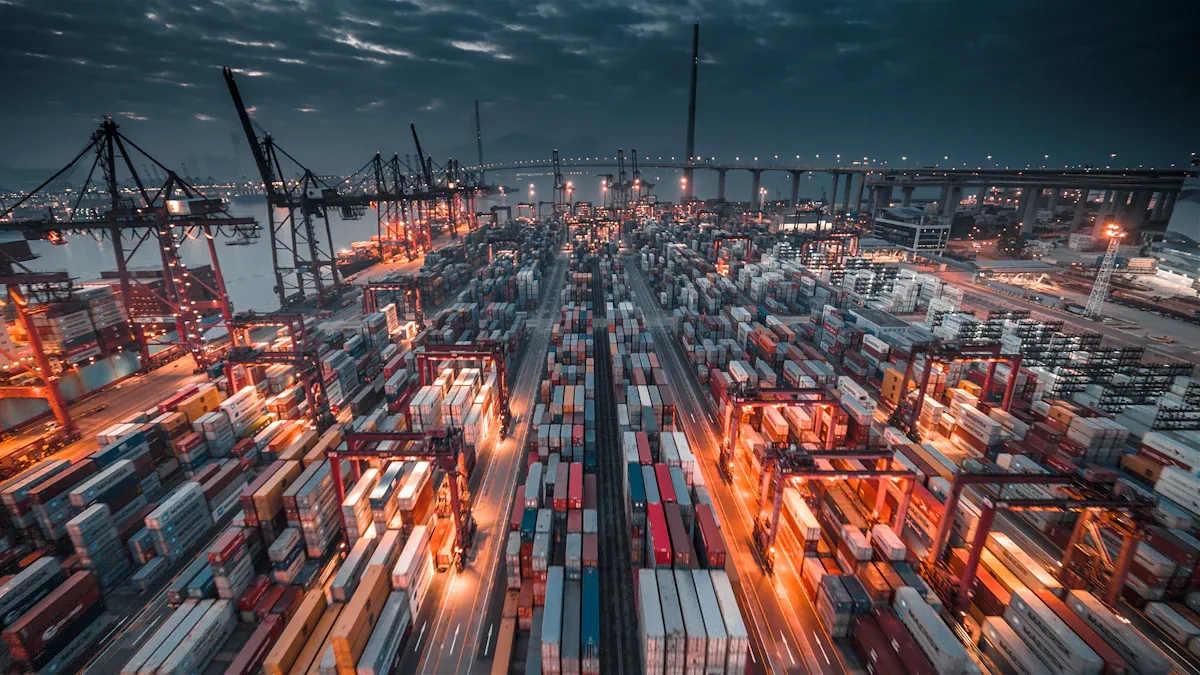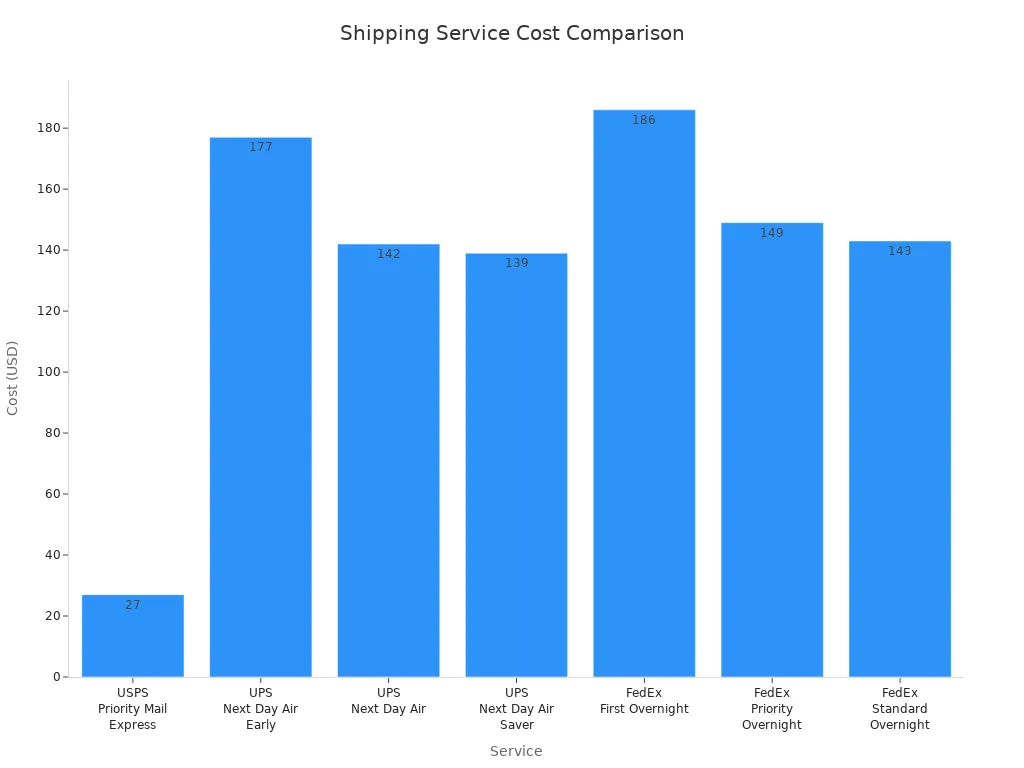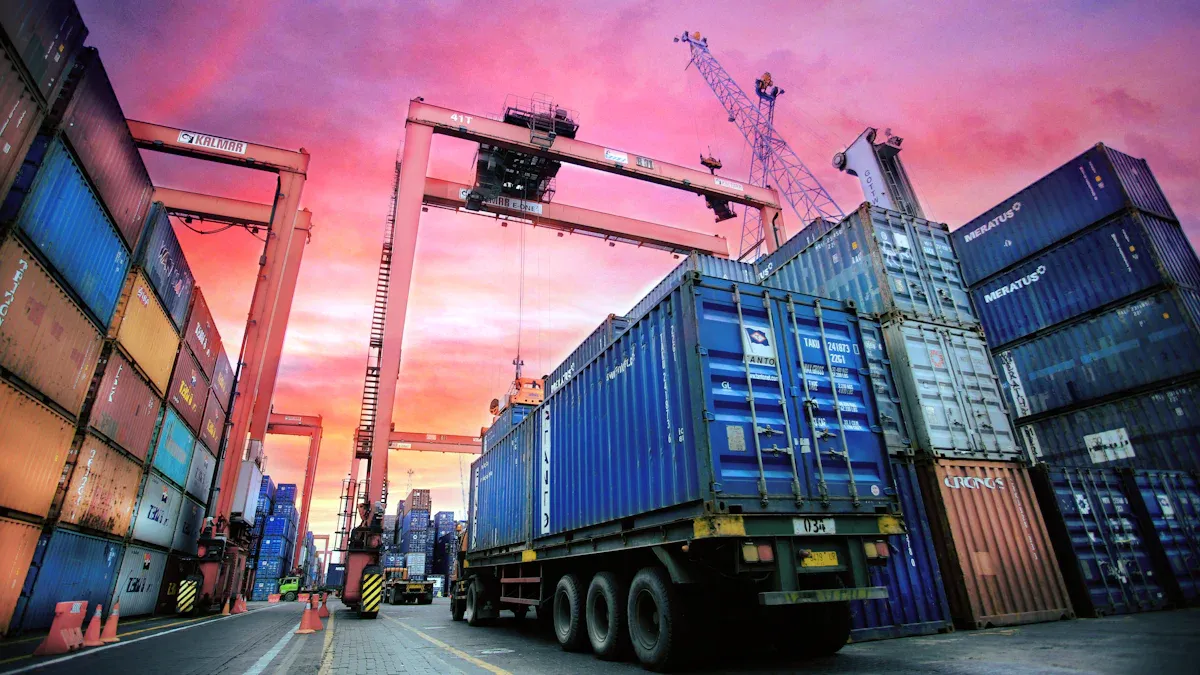How to Choose the Best Transportation Solution for Domestic Shipping in 2025

You need to pick transportation solutions for domestic shipping by looking at both cost and value. Use a cost-benefit analysis to see what each option brings to your business. In 2024, U.S. logistics costs reached $2.58 trillion, with trucking making up nearly 60% of transport expenses. Multi-carrier platforms help you compare rates in real time, automate shipping tasks, and choose the best carrier for every shipment. This approach saves money and keeps your operation flexible.
Key Takeaways
Use a cost-benefit analysis to evaluate transportation options. This helps you understand the value each choice brings to your business.
Choose between full truckload (FTL) and less-than-truckload (LTL) shipping based on your shipment size. FTL is faster and safer for large shipments, while LTL is more economical for smaller loads.
Consider using multi-carrier platforms to compare rates and services. This flexibility allows you to select the best carrier for each shipment, saving money and improving delivery times.
Leverage technology like Transportation Management Systems (TMS) for better control and visibility over shipments. Real-time tracking and automation can enhance efficiency and reduce errors.
Stay informed about industry trends, such as sustainability initiatives and automation. These factors can influence your shipping costs and operational efficiency.
Transportation Solutions for Domestic Shipping

Truckload and LTL
You can choose between full truckload (FTL) and less-than-truckload (LTL) shipping based on your shipment size and speed needs. FTL works best when you have a large shipment that fills an entire truck. It moves faster because the truck goes straight to your destination without extra stops. This method also keeps your cargo safer since fewer people handle it. If you have smaller shipments, LTL lets you share space with other shippers. This option costs less, but it often takes longer and increases the risk of damage because of more stops and handling. LTL service may not be available on low-volume routes, and delivery times can be unpredictable.
Intermodal and Air Freight
Intermodal shipping uses a mix of trucks, trains, and sometimes ships to move goods across long distances. You can save money and lower your carbon footprint with this method. Air freight gives you the fastest delivery for urgent shipments. It costs more, but you get speed and reliability for time-sensitive goods. Many businesses use air freight for high-value or perishable items.
Expedited, Overnight, and Economy Shipping
You have several speed options for transportation solutions for domestic shipping. Expedited shipping moves your goods faster than standard methods. Overnight shipping guarantees next-day delivery, but it comes at a higher price. Economy shipping is the slowest and most affordable choice for non-urgent shipments.
Expedited shipping is generally more expensive but necessary for urgent deliveries, while economy shipping is more cost-effective for non-urgent shipments.
Carrier | Service | Delivery Time | Approx. Cost (5 lbs) |
|---|---|---|---|
USPS | Priority Mail Express® | Next Day by 6PM | $27 |
UPS | Next Day Air® Early | By 8:00 AM | $177 |
UPS | Next Day Air® | By 10:30 AM | $142 |
UPS | Next Day Air Saver® | By End of Day | $139 |
FedEx | First Overnight® | By 8:00 AM | $186 |
FedEx | Priority Overnight® | By 10:30 AM | $149 |
FedEx | Standard Overnight® | By 3:00 PM | $143 |

Dedicated Trucks for Sensitive Freight
Some transportation solutions for domestic shipping use dedicated trucks for sensitive or high-value goods. You can use refrigerated trucks (reefers) for perishables and pharmaceuticals. These trucks keep a steady temperature and monitor it during the trip. Specialized trucks protect electronics and fragile items from shocks and temperature changes. Dedicated services load your freight once and deliver it directly, which reduces handling and risk. Many companies also use advanced tracking to watch shipments in real time.
Key Decision Factors
Cost-Benefit Analysis
When you choose transportation solutions for domestic shipping, you need to look beyond price tags. A cost-benefit analysis helps you see the full picture. You should consider shipping distance, speed, carrier type, fuel surcharges, and extra fees. Industry trends, like the push for faster delivery and sustainability, also affect costs. The table below shows important factors to review:
Factor | Description |
|---|---|
Shipping Distance | Costs rise with longer distances due to zone-based pricing. |
Shipping Speed | Faster shipping options cost more because of urgency. |
Type of Carrier | Carriers set different prices based on service and speed. |
Fuel Surcharges | Changing fuel prices add extra charges to your bill. |
Additional Fees | Handling, peak season, and rural delivery fees increase total costs. |
Industry Trends | Demand for speed and sustainability can change shipping expenses. |
Service Quality and Speed
You want your shipments to arrive safely and on time. Local freight providers move goods quickly over short distances and offer same-day delivery or temperature-controlled transport. Regional carriers give you flexibility and fast delivery, but they work best in certain areas. National carriers handle long routes and complex needs, but they may charge more and move slower for local deliveries. Advanced technology, like real-time tracking, helps you monitor shipments and improve efficiency.
Local providers: Fast for short trips, offer special services.
Regional carriers: Flexible, quick, but limited to certain areas.
National carriers: Good for long distances, handle big shipments.
Shipment Size and Requirements
The size and type of your shipment matter. You need to match your freight to the right shipping method. Use the table below to guide your choice:
Shipping Method | Shipment Size (Pallets) | Weight Range (Pounds) |
|---|---|---|
LTL | 1 to 6 | |
Truckload | Exceeds 6 | Over 10,000 |
If you ship temperature-sensitive products, cold chain logistics keeps items safe. You need special packaging, storage, and trucks to maintain the right temperature. Shipping hazardous materials requires strict safety rules and sometimes temperature control to prevent accidents.
Multi-Carrier Platforms
Multi-carrier platforms help you compare rates from different carriers. You can pick the best option for each shipment, saving money and improving delivery times. These platforms use automated tools to find the best rates and services. You avoid relying on just one carrier, which reduces risks and keeps your shipping flexible.
Tip: Using a multi-carrier platform lets you adapt quickly if one carrier faces delays or disruptions.
Choosing Transportation Solutions for Domestic Shipping
Evaluating Carriers
You need to look at several factors when you choose a carrier for your shipments. Reliable carriers help you deliver goods on time and keep customers happy. You should check how often a carrier delivers on schedule. Look at their service quality and customer support. Good carriers answer questions quickly and solve problems fast. You also want to see if their invoices match the agreed prices and services. Watch for hidden fees and make sure the cost fits your budget.
Delivery lead time includes order processing, packing, and transportation.
Service quality shows how well the carrier handles your shipments and responds to your needs.
Cost efficiency helps you compare pricing models and spot extra charges.
On-time delivery metrics tell you how often shipments arrive as promised.
Rates of damage and loss show how safe your goods are during transport.
Tip: Always review the percentage of on-time deliveries and check for any history of damaged or lost shipments. This helps you avoid problems and keeps your supply chain strong.
Common mistakes can hurt your shipping process. Poor route planning wastes fuel and makes customers unhappy. Uneven load distribution can cause accidents. Skipping documentation and load checks leads to delivery mismatches. Incorrect freight classification may result in extra fees and delays. You should use GPS and route optimization software to find the best paths. Make sure you balance the weight in each truck and keep all shipping documents up to date.
Negotiating Rates
You can save money by negotiating better rates with your carriers. Start by preparing well. Know your shipping needs and the value you bring to the carrier. Build strong relationships through clear communication and respect. Use your shipping data to support your requests. Show your monthly and seasonal shipment volumes, average package weights, and main delivery zones. This information helps you explain why you deserve better rates.
Prepare by understanding your shipping volume and needs.
Build relationships with carriers for smoother negotiations.
Use historical shipping data to support your rate requests.
Stay informed about market conditions to negotiate from a strong position.
When you negotiate, listen to the carrier’s side. Carriers may have objections or counteroffers. Understanding their reasons helps you find common ground and reach a fair deal.
You should also track your service mix, such as ground, express, and international shipments. Keep records of surcharges you have paid in the past. This helps you spot trends and avoid paying too much.
Technology Integration
You can boost your shipping efficiency by using advanced technology. A Transportation Management System (TMS) automates many logistics tasks. TMS gives you better control and visibility over your shipments. Real-time tracking lets you see where your goods are at any moment. This helps you solve problems quickly and keep customers informed.
Modern TMS platforms offer instant truckload pricing, automated load booking, and AI-driven route optimization. These features help you plan the best routes, reduce costs, and avoid delays. Automation streamlines load planning and job assignments, which lowers the chance of mistakes. Integration with warehouse management systems ensures faster and more accurate order fulfillment.
Real-time tracking improves visibility and responsiveness.
Route optimization reduces fuel costs and speeds up deliveries.
Automation makes load planning easier and more reliable.
Integration with other technologies helps you manage data and operations smoothly.
Cost reduction comes from analyzing routes and logistics for savings.
Enhanced customer experience results from real-time updates and reliable deliveries.
You can measure the return on investment (ROI) for technology by looking at increased productivity and reduced waste. Calculate the costs of buying and maintaining the system. Use the formula: ROI = (Benefits - Costs) / Costs x 100%. Improved customer satisfaction and better decision-making also show the value of your investment.
Note: Advanced TMS and real-time tracking help you choose the best transportation solutions for domestic shipping. These tools make your shipping process faster, safer, and more cost-effective.
Trends Shaping Domestic Shipping in 2025

Data Analytics and Tracking
You can use data analytics to make smarter shipping decisions. Predictive analytics helps you forecast demand and spot ways to save money. Shipping data analytics collects and interprets information from many sources, which improves your operations and lowers costs. You can use tools like real-time data integration and machine learning to plan better routes and avoid delays. These tools help you reroute trucks to skip traffic jams and balance delivery loads. Last-mile delivery makes up more than half of shipping costs, so optimizing routes is important.
Predictive analytics reduces travel distance and delivery time.
Real-time tracking improves customer satisfaction with accurate delivery times.
Machine learning matches driver schedules to delivery volumes, which saves money.
Tip: When you use analytics, you can anticipate problems and keep your shipments on track.
Sustainability Initiatives
You can help the environment by choosing efficient transportation methods. Many companies now use alternative fuels and modernize fleets with electric or hybrid vehicles. These changes lower carbon footprints and meet new environmental rules. Rail transport is the most eco-friendly option, producing much less carbon than trucks or planes. Air transport creates the most emissions, while trucks and ships also add pollution. Sustainable practices, like consolidating shipments, reduce waste and improve your brand image.
Efficient transportation methods cut emissions.
Electric and hybrid vehicles are becoming common.
Compliance with environmental regulations is essential.
Sustainable logistics improves reputation and saves money.
Regulation | Effective Date | Description |
|---|---|---|
EPA Emissions Standards | Ongoing | Strict limits for heavy-duty vehicles. |
California ACT | 2025 | Requires zero-emission vehicles. |
Large Shipper Demands | 2025 | Carriers must show sustainability commitments. |
Note: Sustainable logistics practices help your business and the planet.
Automation and Compliance
Automation makes your shipping process faster and more accurate. Automated systems handle routine tasks, which reduces manual work and errors. You can use packing list automation to sync data with your ERP system and avoid mistakes. Automated compliance processes help you follow regulations without extra effort. These systems book shipments, generate invoices, and keep records up to date.
Automation lets you scale your operations while keeping everything accurate. You spend less time on paperwork and more time serving customers. New rules, like tariffs and forced labor laws, require careful compliance. Automated tools help you meet these requirements and avoid penalties.
Effective Date | Description | |
|---|---|---|
New Tariffs (China & Hong Kong) | Feb 4, 2025 | Extra tariffs and new entry rules. |
Tariff Suspensions (Canada & Mexico) | Until Mar 4, 2025 | Temporary changes for North American trade. |
Forced Labor Regulations | Ongoing | Stricter enforcement for compliance. |
Alert: Automation helps you stay compliant with changing regulations and reduces costly errors.
You can choose the best transportation solutions for domestic shipping by following clear steps. First, match your shipment size and urgency to the right method, such as LTL for small loads or TL for large, fast deliveries. Next, use a cost-benefit analysis to compare costs and benefits. Technology helps you track shipments and improve safety. Before making a final decision, review this checklist:
Confirm carrier reliability and delivery speed.
Use electronic logging devices for safety monitoring.
Tip: When you use these steps, you make smart choices that fit your business needs.
FAQ
What is the difference between LTL and truckload shipping?
LTL shipping lets you share space with other shippers. Truckload shipping uses the whole truck for your goods. You choose LTL for small shipments and truckload for large ones.
How does technology improve domestic shipping?
You use technology to track shipments in real time. Automated systems help you plan routes and book loads faster. Technology reduces mistakes and saves money.
Why should you use a multi-carrier platform?
Multi-carrier platforms let you compare rates and services. You pick the best carrier for each shipment. This helps you avoid delays and lower costs.
What steps help you choose the right carrier?
You check delivery speed, safety records, and customer reviews. You compare prices and look for hidden fees. You use shipping data to make smart choices.
See Also
Enhancing Global Operations Through Innovative Logistics Solutions
Streamlining Supply Chains With American Global Logistics Services
Boosting Global Efficiency With Point-to-Point Logistics Systems
